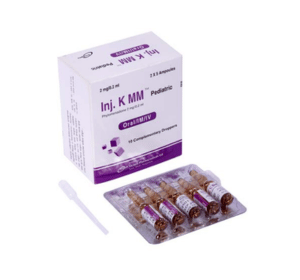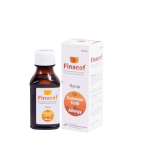Inj. K MM(Phytomenadione)

Therapeutic Group: Vitamins and Minerals
Presentation
Inj. K MM : Each ampoule contains 10 mg of Phytomenadione BP in 1 ml of clear solution.
Inj. K MM Pediatric: Each ampoule contains 2 mg of Phytomenadione BP in 0.2 ml of clear solution.
Description
Vitamin K1 (Phytomenadione) is a procoagulant factor. As a component of a hepatic carboxylase system, Vitamin K1 is involved in the post-translational carboxylation of clotting factors II (Prothrombin), VII, IX and X and the clotting inhibitors protein C and protein S. Coumarins inhibit the reduction of Vitamin K1 (quinone form) to Vitamin K1 (hydroquinone) and also prevent the Vitamin K1 epoxide arising after carboxylation from being reduced to the quinone form.
Vitamin K1 is an antagonist of coumarin-type anticoagulants, e.g. Phenprocoumon. It does not, however, neutralise the activity of Heparin; Protamine is the antagonist of Heparin.
Vitamin K1 is ineffective in hereditary hypoprothrombinemia or hypoprothrombinemia induced by severe hepatic failure.
Lack of Vitamin K1 leads to an increased tendency to haemorrhagic disease in the newborn. Vitamin K1 administration, which promotes synthesis of the above-mentioned coagulation factors by the liver, can reverse an abnormal coagulation status and bleeding due to vitamin K1 deficiency.
Indications
Haemorrhage or risk of haemorrhage as a result of severe ‘hypoprothrombinemia’ (i.e. deficiency of clotting factors II, VII, IX and X) of various etiologies, including overdosage of courmarin-type anticoagulants, their combination with Phenylbutazone, and other forms of hypovitaminosis K (e.g. in obstructive jaundice as well as liver and intestinal disorders, and after prolonged treatment with antibiotics, sulphonamides or salicylates).
Prophylaxis and treatment of haemorrhagic disease in the newborn.
Dosage & Administration
Adults
Standard dosage
Severe haemorrhage e.g: during anticoagulant therapy.
The anticoagulant should be withdrawn and an IV injection of Inj K MM given slowly (in at least 30 seconds) in a dose of 10-20 mg (1-2, 10 mg ampoules). The Prothrombin level should be estimated three hours later and if the response has been inadequate, the dose should be repeated. Not more than 50 mg of Inj K MM should be given IV in 24 hours. Inj. K MM therapy should be accompanied, when necessary i.e. in life-threatening situations, by a more immediately effective treatment such as transfusions of whole blood or blood-clotting factors.
Neonates with special risk factors (e.g. prematurity, birth asphyxia, obstructive jaundice, inability to swallow, maternal use of anticoagulants or antiepileptics):
1 mg intramuscularly or intravenously at birth or shortly after birth if the oral route is unsuitable.
Intramuscular and intravenous doses should not exceed 0.4 mg/kg (equivalent to 0.04 ml/kg) in premature infants weighing less than 2.5 kg (see Precautions).
The size and frequency of further doses should be based on coagulation status.
Side Effects
There are isolated unconfirmed reports on the possible occurrence of anaphylactoid reactions after parenteral use of Phytomenadione mixed-micelle solutions. Very rarely, venous irritation or phlebitis has been reported in association with parenteral administration of Phytomenadione.
Precautions
At the time of use, the mixed micelle ampoule solutions must be clear. Following incorrect storage, the solution may become turbid or a phase separation may occur. In such cases, the ampoule must not be used.
When patients with severely impaired liver function are treated, the formation of prothrombin may be impaired. Therefore, careful monitoring of the coagulation parameters is necessary after administration of Inj. K MM.
In potentially fatal and severe haemorrhage due to overdosage of coumarin anticoagulants, IV injections of Inj. K MM should be accompanied by a more immediately effective treatment, such as transfusions of whole blood or blood-clotting factors. When patients with prosthetic heart valves are given transfusions for the treatment of severe or potentially fatal haemorrhages, fresh frozen plasma should be used.
Large doses of Inj. K should be avoided if it is intended to continue with anticoagulant therapy.
Parenteral administration may be associated with an increased risk of kernicterus in premature infants weighing less than 2.5 kg.
Use in Pregnancy & Lactation
Pregnancy: No controlled studies of Phytomenadione have been performed in animals or pregnant women. On the basis of many years’ clinical experience, however, it is safe to assume that neither Vitamin K1 nor the excipients contained in the Phytomenadione formulations have any reproductive toxicological effects when the medicine is given at the recommended dosages. As with all medications, however, Phytomenadione should be given to pregnant women only if the benefit to the mother outweighs the risk to the fetus.
As Vitamin K1 does not readily cross the placental barrier, it is not recommended that Phytomenadione be given to expectant mothers as prophylaxis of haemorrhagic disease in the newborn.
Lactation: Only a small fraction of administered Vitamin K1 enters the breast milk. At therapeutic doses, administration of Phytomenadione to nursing mothers accordingly does not pose a risk to their infants. However, Phytomenadione is not recommended for nursing mothers as prophylaxis of haemorrhagic disease in the newborn.
Drug Interaction
Vitamin K1 antagonises the effect of coumarin-type anticoagulants.
Coadministration of anticonvulsants can impair the action of vitamin K1.
Over Dose
No overdose effects are known
Commercial Pack
Inj. K MM : Each box contains 5 ampoules of 10 mg/ml Phytomenadione BP.
Inj. K MM Pediatric: Each box contains 10 ampoules of 2 mg/0.2 ml Phytomenadione BP.



